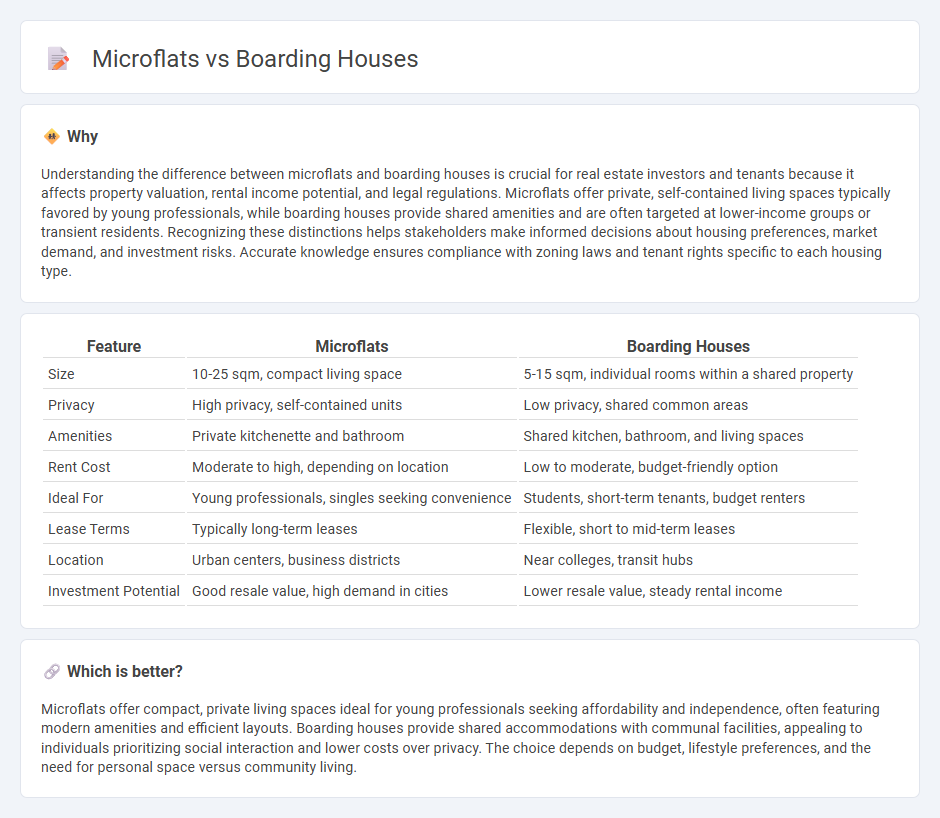
Microflats offer compact, self-contained living spaces with modern amenities, ideal for urban professionals seeking privacy and convenience. Boarding houses provide affordable, communal living options with shared facilities, attracting students and transient workers. Discover the key differences and benefits of microflats versus boarding houses to choose the best option for your lifestyle.
Why it is important
Understanding the difference between microflats and boarding houses is crucial for real estate investors and tenants because it affects property valuation, rental income potential, and legal regulations. Microflats offer private, self-contained living spaces typically favored by young professionals, while boarding houses provide shared amenities and are often targeted at lower-income groups or transient residents. Recognizing these distinctions helps stakeholders make informed decisions about housing preferences, market demand, and investment risks. Accurate knowledge ensures compliance with zoning laws and tenant rights specific to each housing type.
Comparison Table
| Feature | Microflats | Boarding Houses |
|---|---|---|
| Size | 10-25 sqm, compact living space | 5-15 sqm, individual rooms within a shared property |
| Privacy | High privacy, self-contained units | Low privacy, shared common areas |
| Amenities | Private kitchenette and bathroom | Shared kitchen, bathroom, and living spaces |
| Rent Cost | Moderate to high, depending on location | Low to moderate, budget-friendly option |
| Ideal For | Young professionals, singles seeking convenience | Students, short-term tenants, budget renters |
| Lease Terms | Typically long-term leases | Flexible, short to mid-term leases |
| Location | Urban centers, business districts | Near colleges, transit hubs |
| Investment Potential | Good resale value, high demand in cities | Lower resale value, steady rental income |
Which is better?
Microflats offer compact, private living spaces ideal for young professionals seeking affordability and independence, often featuring modern amenities and efficient layouts. Boarding houses provide shared accommodations with communal facilities, appealing to individuals prioritizing social interaction and lower costs over privacy. The choice depends on budget, lifestyle preferences, and the need for personal space versus community living.
Connection
Microflats and boarding houses both address the growing demand for affordable, space-efficient urban living solutions by maximizing limited real estate in densely populated cities. These housing models optimize smaller footprints by offering compact, functional units that cater to transient residents, students, or young professionals seeking cost-effective accommodation. Their interconnectedness lies in providing scalable residential options that alleviate housing shortages while promoting shared amenities and community living.
Key Terms
Occupancy Density
Boarding houses typically feature shared amenities with higher occupancy density, often accommodating multiple tenants per room to maximize space utilization. Microflats prioritize compact, self-contained units designed for individual residents, resulting in lower occupancy density but enhanced privacy. Explore more about how occupancy density impacts living conditions and urban planning strategies.
Lease Duration
Boarding houses commonly offer flexible lease durations ranging from short-term stays of a few weeks to several months, catering to transient tenants or students. Microflats typically require longer lease commitments, often spanning six months to a year, aligning with the needs of professionals seeking stability. Discover detailed comparisons and lease options to find the best fit for your housing needs.
Shared Amenities
Boarding houses offer communal kitchens, shared bathrooms, and social common areas that encourage interaction among residents, fostering a sense of community. Microflats typically provide private kitchens and bathrooms within individual units, with limited shared amenities such as laundry facilities or small lounges. Explore more about how these living options impact lifestyle and convenience by delving deeper into their shared amenities.
Source and External Links
Boarding house - A boarding house is a family home or similar where lodgers rent rooms, often with meals provided (room and board), and with shared or private facilities; residents have a license but no exclusive possession, and they can arrange bed-and-breakfast, half-board, or full-board stays.
The Boarding Houses - Lowell - Early boarding houses in Lowell, Massachusetts, housed 20 to 40 single female textile workers and included common areas like kitchens and dining rooms, with design evolving to brick rowhouses reflecting the Georgian style by the mid-1830s.
What Are Boarding Houses? And How Do They Work? - Boarding houses provide lodging plus meals and sometimes laundry and cleaning, and can range from traditional homes renting rooms to modern variations including bed and breakfasts or Airbnb setups, requiring attention to local regulations.
 dowidth.com
dowidth.com